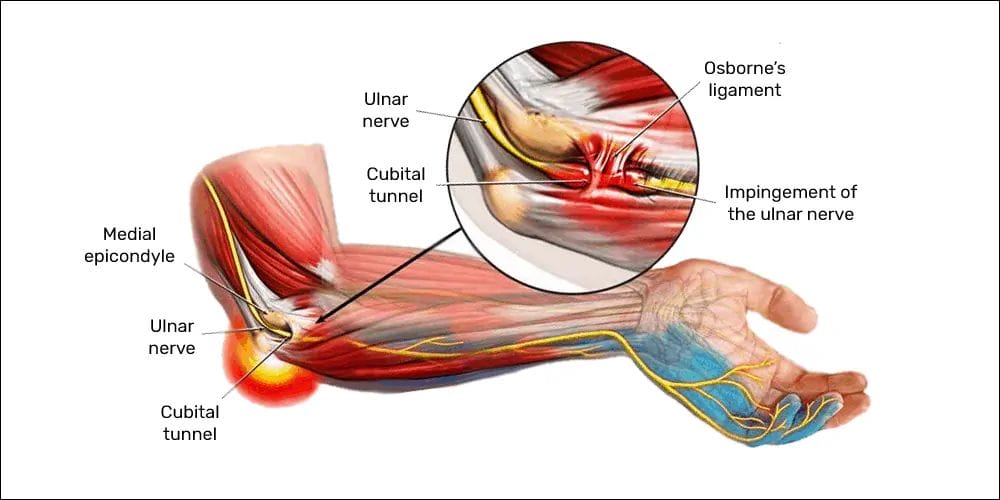Cubital Tunnel Syndrome
Patient Information
Overview
Cubital tunnel syndrome is also known as ulnar neuropathy, caused by increased pressure from the bone or connective tissue on a nerve in the wrist, arm or elbow. Early symptoms can be managed with conservative treatments, but more severe cases may require surgery to reduce pressure on the affected nerve.
Causes and Symptoms of Cubital Tunnel
Cubital tunnel syndrome is caused by increased pressure on the ulnar nerve, which passes close to the surface of the skin in the area of the elbow commonly known as the “funny bone.”
These factors may make one more likely to develop cubital tunnel syndrome:
-
-
- Prior fracture or dislocations of the elbow
- Bone spurs/ arthritis of the elbow
- Swelling of the elbow joint
- Cysts near the elbow joint
- Repeatedly lean on your elbow, especially on a hard surface
- Bend your elbow for sustained periods, such as while talking on a cell phone or sleeping with your hand crooked under your pillow
- Abnormal bone growth in the elbow
- Intense physical activity, such as being a baseball pitcher, may increase pressure on the ulnar nerve
-
Early symptoms include:
-
-
- Pain and numbness in the elbow
- Tingling, especially in the ring and little fingers
-
More severe symptoms include:
-
-
- Weakness affecting the ring and little fingers
- Decreased ability to pinch the thumb and little finger
- Decreased overall hand grip
- Muscle wasting in the hand
- Claw-like deformity of the hand
-
If you have any of these symptoms, your doctor may be able to diagnose cubital tunnel syndrome by physical examination alone or order an electromyography to confirm the diagnosis and its severity.
Treatment
Cubital tunnel syndrome often can be managed conservatively, especially if electromyography reveals that there is minimal pressure on the ulnar nerve.
Nonsurgical Treatment
-
-
- Avoid undue pressure on the elbow: For instance, do not drive with your arm resting on the open window or sleep with your arms bent under the pillows.
- Non-steroidal anti-inflammatory medicines: For early symptoms, anti-inflammatory medicine, such as ibuprofen and naproxen, may help reduce soft tissue swelling around the nerve.
- Steroids injections, such as corticosteroid might be effective to relieve inflammation and pressure on the radial nerve. However, they are not common practice as they may damage the nerve.
- Splint: Wearing a splint during sleep to prevent over-bending of the elbow. Another option is by wrapping a towel around your straight elbow or wearing an elbow pad backwards.
- Nerve gliding exercises: Some doctors see improvements in patients who perform exercises that help the ulnar nerve slide through the cubital tunnel at the elbow and the wrist to prevent stiffness. Stretching/strengthening exercises and other interventions such as heat, cold, and ultrasound have shown beneficial results.
-
Surgical Treatment
In severe cases where conservative treatments do not achieve desirable results, your doctor may recommend surgery to relieve pressure on the radial nerve. Surgery may be recommended particularly in cases where the wrist becomes weak or droopy or it becomes difficult to extend the fingers. There are a limited number of procedures that your surgeon will discuss further with you to determine the best approach.
-
-
- Cubital tunnel release: In this operation, the ligament “roof” of the cubital tunnel is cut and divided. This decreases pressure on the nerve by expanding the size of the tunnel.
- As the ligament heals, new tissue will grow across the division to allow more space for the ulnar nerve to slide through. This procedure achieves the best result when the nerve compression is mild to moderate and the nerve does not slide out from behind the bony ridge of the bending elbow.
- Ulnar nerve anterior transposition: In this procedure, the nerve is often moved from its place behind the medial epicondyle to a new place in front of it. Moving the nerve to the front of the medial epicondyle prevents it from getting caught on the bony ridge and stretching when you bend your elbow.
- However, the nerve can be moved to lie under the skin and fat but on top of the muscle (subcutaneous transposition), or within the muscle (intermuscular transposition), or under the muscle (submuscular transposition).
- Medial epicondylectomy: Another option to release the nerve is to remove part of the medial epicondyle. Like ulnar nerve transposition, this technique also prevents the nerve from getting caught on the boney ridge and stretching when your elbow is bent.
- Cubital tunnel release: In this operation, the ligament “roof” of the cubital tunnel is cut and divided. This decreases pressure on the nerve by expanding the size of the tunnel.
-
Surgical Recovery
Depending on the type of surgery you have, you may need to wear a splint for a few weeks after the operation. A submuscular transposition usually requires a longer time (3 to 6 weeks) in a splint. Your surgeon may recommend physical therapy exercises to help you regain strength and motion in your arm. He will also talk with you about when it will be safe to return to all your normal activities.
Surgical Outcome
The results of surgery are generally good with similar success rate with each surgical method for most routine cases. If the nerve is severely compressed or if there is muscle wasting, the nerve may not recover fully to its original state and some symptoms may remain. Keep in mind that nerves recover slowly, and it may take a period of time to know how well the nerve will do after surgery.
References:
OrthoInfo. (2020). Ulnar nerve entrapment at the elbow: Cubital tunnel syndrome. Retrieved from https://orthoinfo.aaos.org/en/diseases–conditions/ulnar-nerve-entrapment-at-the-elbow-cubital-tunnel-syndrome/
WebMD. (2018). Cubital and radial tunnel syndrome. Retrieved from https://www.webmd.com/pain-management/cubital-radial-tunnel-syndrome#3


